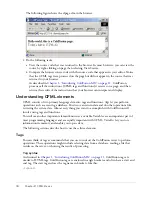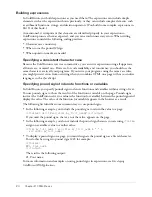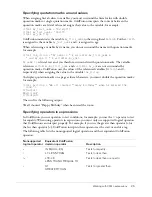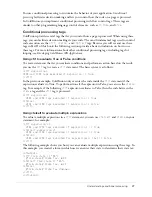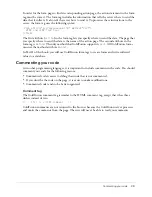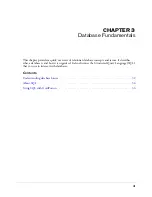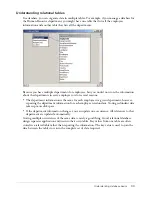
26
Chapter 2: CFML Basics
Arithmetic operators
The following table lists the arithmetic operators that ColdFusion supports:
String operator
The following table describes the one ColdFusion string operator that is a concatenation
operator:
Understanding conditional processing
To this point, all the coding examples shown are considered linear coding examples.
Linear code
is
when ColdFusion executes code starting with the first line on the page, and processes every line in
order. Although you will use linear code in your applications, you will often write code that
performs various actions based on conditions, such as the following:
•
Determine if a user entered a value in a form field.
•
Display results based on user input.
•
Display messages based on the time of day.
>=
GTE,
GREATER THAN OR EQUAL TO
Tests for greater than or equal to
< >
IS NOT, NEQ,
NOT EQUAL
Tests for nonequality.
CONTAINS
Tests whether a value is contained within a
second value.
DOES NOT CONTAIN
Tests whether a value is not contained
within a second value.
Operators Description
+, -, *, /
The basic arithmetic operators: addition, subtraction, multiplication, and division.
In the case of division, the right operand cannot be zero.
+, -
Unary arithmetic operators for setting the sign of a number either positive or
negative (+ or -).
Mod
Returns the remainder (modulus) after a number is divided by a divisor. The result
has the same sign as the divisor. The right operand cannot be zero; for example:
11 MOD 4 is 3.
\
Divides two integer values. Use the \ (trailing slash) to separate the integers. The
right operand cannot be zero; for example: 9 \ 4 is 2.
^
Returns the result of a number raised to a power (exponent). Use the ^ (caret) to
separate the number from the power. The left operand cannot be zero; for
example: 2 ^ 3 is 8.
Operator
Description
&
Concatenates strings.
Nonsupported
logical operator
Equivalent ColdFusion
decision operator
Description
Summary of Contents for COLDFUSION MX 61-GETTING STARTED BUILDING COLDFUSION...
Page 1: ...Getting Started Building ColdFusion MX Applications...
Page 6: ...6 Contents...
Page 10: ......
Page 30: ...30 Chapter 2 CFML Basics...
Page 36: ...36 Chapter 3 Database Fundamentals...
Page 48: ......
Page 76: ...76 Chapter 6 Lesson 2 Writing Your First ColdFusion Application...
Page 134: ...134 Index...







